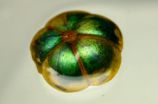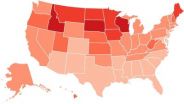(Press-News.org) New research from the University of British Columbia is shedding light on why enticing pictures of food affect us less when we're full.
"We've known that insulin plays a role in telling us we're satiated after eating, but the mechanism by which this happens is unclear," says Stephanie Borgland, an assistant professor in UBC's Dept. of Anesthesiology, Pharmacology and Therapeutics and the study's senior author.
In the new study published online this week in Nature Neuroscience, Borgland and colleagues found that insulin – prompted by a sweetened, high-fat meal – affects the ventral tegmental area (VTA) of the brain, which is responsible for reward-seeking behaviour. When insulin was applied to the VTA in mice, they no longer gravitated towards environments where food had been offered.
"Insulin dulls the synapses in this region of the brain and decreases our interest in seeking out food," says Borgland, "which in turn causes us to pay less attention to food-related cues."
"There has been a lot of discussion around the environmental factors of the obesity epidemic," Borgland adds, pointing to fast food advertising bans in Quebec, Norway, the U.K., Greece and Sweden. "This study helps explain why pictures or other cues of food affect us less when we're satiated – and may help inform strategies to reduce environmental triggers of overeating."
The VTA has also been shown to be associated with addictive behaviours, including illicit drug use. Borgland says better understanding of the mechanism in this region of the brain could, in the long run, inform diagnosis and treatment.
###
The study is available at dx.doi.org/10.1038/nn.3321
When food porn holds no allure: The science behind satiety
2013-01-29
ELSE PRESS RELEASES FROM THIS DATE:
Power helps you live the good life by bringing you closer to your true self
2013-01-29
How does being in a position of power at work, with friends, or in a romantic relationship influence well-being? While we might like to believe the stereotype that power leads to unhappiness or loneliness, new research indicates that this stereotype is largely untrue: Being in a position of power may actually make people happier.
Drawing on personality and power research, Yona Kifer of Tel Aviv University in Israel and colleagues hypothesized that holding a position of authority might enhance subjective well-being through an increased feeling of authenticity. The researchers ...
Artificial pancreas: The way of the future for treating type 1 diabetes
2013-01-29
Montréal, January 28, 2013 – IRCM researchers, led by endocrinologist Dr. Rémi Rabasa-Lhoret, were the first to conduct a trial comparing a dual-hormone artificial pancreas with conventional diabetes treatment using an insulin pump and showed improved glucose levels and lower risks of hypoglycemia. Their results, published today in the Canadian Medical Association Journal (CMAJ), can have a great impact on the treatment of type 1 diabetes by accelerating the development of the external artificial pancreas.
The artificial pancreas is an automated system that simulates ...
Why are there redheads? Birds might hold the clues
2013-01-29
Red coloration—historically seen as costly in vertebrates—might represent some physiological benefit after all, according to research published in the journal Physiological and Biochemical Zoology.
Pheomelanin, which is responsible for red hair and freckles in humans and orange and chestnut coloration in other animals, is known to increase the damage to skin cells and melanoma risk when present in large amounts. Furthermore, its creation involves the consumption of glutathione, a beneficial antioxidant.
In an attempt to unearth the factors favoring the evolution of ...
AGU Journal Highlights -- Jan. 28, 2013
2013-01-29
The following highlights summarize research papers that have been recently published in Geophysical Research Letters (GRL), Water Resources Research, Journal of Geophysical Research – Planets (JGR-E), Journal of Geophysical Research – Oceans (JGR-C), and Journal of Geophysical Research-Biogeosciences (JGR-G).
In this release:
1. Io's volcanism controls Jupiter's magnetospheric activity
2. Projected U.S. water use likely to increase as climate warms
3. Mercury's crust likely made of magnesium-rich basalt
4. Assessing the Great Whirl, despite all the pirates
5. Tracing ...
Bioinspired fibers change color when stretched
2013-01-29
Cambridge, Mass. – January 28, 2013 - A team of materials scientists at Harvard University and the University of Exeter, UK, have invented a new fiber that changes color when stretched. Inspired by nature, the researchers identified and replicated the unique structural elements that create the bright iridescent blue color of a tropical plant's fruit.
The multilayered fiber, described today in the journal Advanced Materials, could lend itself to the creation of smart fabrics that visibly react to heat or pressure.
"Our new fiber is based on a structure we found in nature, ...
Innovative uses of nanotechnology in food and agriculture
2013-01-29
New Rochelle, NY, January 28, 2013—The U.S. Department of Agriculture (USDA) invests nearly $10 million a year to support about 250 nanoscale science and engineering projects that could lead to revolutionary advances in agriculture and food systems. Examples of current projects in development are presented in a Special Research Section published in Industrial Biotechnology, a peer-reviewed journal from Mary Ann Liebert Inc., publishers. The articles are available on the Industrial Biotechnology website.
In their introductory article, "Overview: Nanoscale Science and ...
Skin, soft tissue infections succumb to blue light
2013-01-29
Blue light can selectively eradicate Pseudomonas aeruginosa infections of the skin and soft tissues, while preserving the outermost layer of skin, according to a proof-of-principle study led by Michael R. Hamblin of the Massachusetts General Hospital, and the Harvard Medical School, Boston. The research is published online ahead of print in the journal Antimicrobial Agents and Chemotherapy
"Blue light is a potential non-toxic, non-antibiotic approach for treating skin and soft tissue infections, especially those caused by antibiotic resistant pathogens," says Hamblin. ...
Injecting botox into stomach does not promote weight loss
2013-01-29
Bethesda, MD (Jan. 28, 2013) – Despite conflicting data in support of the practice, some overweight Americans looking for an easy fix have turned to gastric botox injections to help them lose weight. This month in Clinical Gastroenterology and Hepatology, the official clinical practice journal of the American Gastroenterological Association, researchers from the Mayo Clinic publish a definitive study finding that Botox doesn't promote weight loss.
Injecting botulinum toxin A (BTA), or Botox, into the stomach had been believed to delay emptying of the stomach, increase ...
New study shows stable fisher population in the Southern Sierra Nevada
2013-01-29
ARCATA, Calif.—After experiencing years of population decline on the West Coast, a recent study examining fisher populations found that—at least in the southern Sierra Nevada—the animal's numbers appear to be stable.
Scientists from the U.S. Forest Service's Pacific Southwest Research Station (PSW) and the Pacific Southwest Region collaborated to monitor the distribution of fishers across a 7,606-square-mile area in the southern Sierra Nevada. They used baited track-plate stations—an enclosure where the fisher leaves a sooted track print as it walks through—at 223 locations ...
Using Twitter to track the flu: A better way to screen the Tweets
2013-01-29
Sifting through social media messages has become a popular way to track when and where flu cases occur, but a key hurdle hampers the process: how to identify flu-infection tweets. Some tweets are posted by people who have been sick with the virus, while others come from folks who are merely talking about the illness. If you are tracking actual flu cases, such conversations about the flu in general can skew the results.
To address this problem, Johns Hopkins computer scientists and researchers in the university's School of Medicine have developed a new tweet-screening ...


